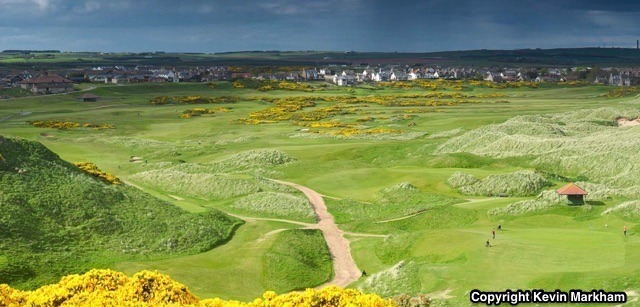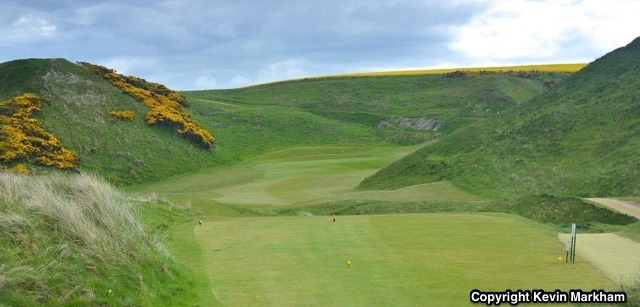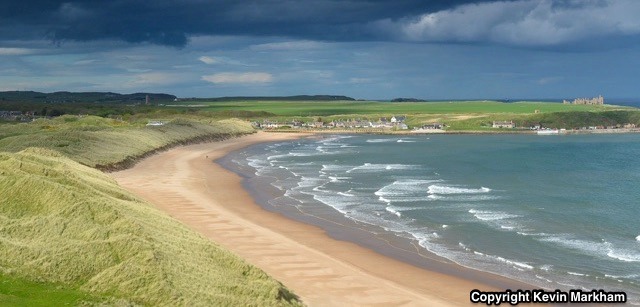Cruden Bay Feature Review
Post from golf writer and golf blogger Kevin Markham.
It is difficult, nigh on impossible, to talk about Cruden Bay without immediately mentioning the views as you step out of the car. It is the sort of dramatic introduction to a golf course that sets the tempo for the day, for the clubhouse sits high above the course with views stretching north and south.
Out to sea, on a narrow headland, sits Slains Castle. It was from here that Bram Stoker drew his inspiration for Dracula, returning on numerous occasions to breathe a darkness into his book that has affected generations of readers.
Closer to home, you feel as if the entire course is laid out beneath your feet, rumbling between the dunes and gorse that stretch between you and the sea.

The trouble is, you have been fooled… on two fronts: first, the most obvious holes on show belong to the 9-hole St Olaf course; and second, the best holes are hidden away in and by deeper dunes.
Golf has been played here since 1899. The course was designed by Old Tom Morris and Archie Simpson, remodelled in 1926 and, in 2014/15, three holes were revitalised by Tom Mackenzie. But the truth is, it is the original designers who retain the credi, for little has changed in the intervening 100 years. The course still weaves its way around the dunes in a figure of eight and the intersection just adds some extra intrigue.
So what makes Cruden Bay so special?
Could it be those opening views that serve as an aperitif? Could it be the scale and shape of the dunes, which vary so constantly? Perhaps it is the blind shots that take you back to a more traditional time and set the nerves jangling? Or maybe it’s the strikingly natural feel of the course, the quirkiness of several holes, the variety of shots you have to play, the elevated tee boxes showing off the holes so perfectly, the bumping, twisting fairways, or the slick greens and their tricky run-offs. Or maybe it’s just the sheer adventure that Cruden Bay promises.
There’s no doubt that the story behind that adventure begins at the clubhouse. When you stand on the path above the 1st tee, look to your right, to the tallest dune. You may well see people standing there, waiting to play the Index 1 9th hole. Tell me that doesn’t raise a goosebump or two.
You’ve got some way to go before you find the answers to those questions, and Cruden Bay will be asking a few questions of its own long before you get there.
It would be unfair to single out the opening and closing four holes (1, 2, 17 and 18) as weak holes, but compared to the others, consider them a warm up and a cool down to what’s in between. What you will learn on those opening holes, however, is that weak shots will be severely punished and finding the correct side of the fairway is essential. Greens welcome bump and run approaches, but considering the severity of the slopes around the putting surfaces, you’ll need to have your shot-making dialled in. The 2nd hole has the steepest of rises up to the green and a fall-off immediately at the back. This is no place for the weak of stomach.
What follows, from the 3rd to the 8th, is special. Greens sit up, perched and intimidating (4, 6, 7), fairways flow through valleys below the tee (5, 6, 8), and blind shots set the pulse racing (3, 6, 7). This is what sets links golf apart. The 3rd and 8th are very short holes (230-270 yards) but they will still damage your card – and pride – if not tackled sensibly. Yes, Cruden Bay’s rough and the angles of some holes will make fools of us all.
The climb to the 9th tee is a long one, but never has a climb to a tee been more worthwhile. This is spectacular, both for its views over the course and across the sea. This downhill hole is Index 1 and that may have something to do with your heartbeat rate rather than the difficulty of the hole. The short par four 10th continues the downhill theme, bringing you back down to the ‘floor’ of the course.
You are now at the farthest reaches of Cruden Bay, with one of the best holes in golf to come. But you have yet to play the long par five 13th beside the sea. This seemingly innocuous hole (from the tee) has you driving towards the 9th green on the dune top above you. A hidden burn awaits but the bigger surprise is yet to come: after two good shots you are unlikely to see the green or the flag. A dune blocks them from view and only a marker post on the hill guides you.
The 14th at Cruden Bay is 400 yards of beauty, class and terror. It is Index 2, squeezed between the sea and the giant dune that is home to the 9th, high above you. The fairway is mostly invisible from the tee as the hole doglegs right, behind a ridge of dunes. Find the fairway and you have a chance… for the approach is all uphill, over sea-sawing fairway, to a crest where a marker post stands. The green nestles down on the other side, narrow, long and cupped like a flat-bed canoe. Only two of your best shots will see you on the green, but it is the type of hole you will want to go straight back to the tee for another attempt.
The same is true of the par three 15th. It is a blind hole of 200 yards, which seems almost unfair under the circumstances. A marker board on the tee, right above the beach, shows where the flag is positioned but for newcomers it is always hit and hope. The view of the hole is blocked by a shoulder of that same giant dune. Yet, while the distance reads 200 yards, you only need to hit it 160-170 as there is a gentle slope running down to the green.
Another par three follows, where the two loops of the figure eight intersect, before you head for home and that restaurant/bar high above the course.
While some golfers might feel the blind shots at Cruden Bay are unfair and too demanding, and the green run-offs severe, this course gets to the heart of your links golfing abilities… and with such a variety of holes and challenges, it is never less than thrilling. And it is never less than inspiring.
Golf costs £100 a round or £135 for a weekday day ticket.
Website: http://www.crudenbaygolfclub.co.uk
Kevin Markham is an Irish golf writer, blogger and photographer who writes for a number of Irish and UK golf websites & magazines. His book 'Hooked: An Amateur's Guide to the Golf Courses of Ireland' was published in 2011 and reviews all 350 golf courses which he played whilst travelling round Ireland in a campervan.
To read his blog visit: www.theirishgolfblog.com
Related Content:



















